
Nov . 30, 2024 17:02 Back to list
Understanding the Applications and Benefits of HPMC in Various Industries
What is HPMC Used For?
Hydroxypropyl methylcellulose (HPMC) is a versatile polymer that finds applications across various industries due to its unique properties. This semi-synthetic derivative of cellulose is produced from natural cellulose through a series of chemical modifications. HPMC is widely known for its use as a thickening agent, emulsifier, and film-forming agent, making it an essential ingredient in many formulations.
One of the primary applications of HPMC is in the pharmaceutical industry. It serves as a crucial component in drug formulations, particularly in controlled-release dosage forms. HPMC is used as a matrix-forming agent that allows for the sustained release of active pharmaceutical ingredients (APIs) over an extended period. This property not only improves the bioavailability of certain medications but also enhances patient compliance by reducing the frequency of dosing. Additionally, HPMC is utilized in tablet binders and coatings, aiding in the formation and stability of tablets while masking unpleasant tastes.
What is HPMC Used For?
The cosmetics and personal care industry also benefits from the use of HPMC. It serves as a thickener in creams, lotions, and gels, contributing to the desired viscosity and texture of products. HPMC is often used in hair care products, providing a film-forming effect that aids in styling and holds while keeping hair moisturized. Its non-irritating nature makes it a suitable component for sensitive skin formulations, providing a smooth application without adverse effects.
what is hpmc used for

In construction and building materials, HPMC is widely used as an additive in cement, mortars, and tile adhesives. It improves workability, water retention, and adhesion properties, making it easier to apply and enhancing the durability of the final product. HPMC also helps to improve the stability of these materials, reducing the risk of cracking and enhancing overall performance.
In the realm of 3D printing, HPMC has emerged as a valuable material due to its film-forming and binding properties. It is often used in the development of filaments for 3D printing, providing strength and flexibility to printed objects. This application reflects the growing trend and innovation within the additive manufacturing sector, where HPMC is leveraged to create high-quality printed components.
Finally, HPMC is also gaining popularity in the agricultural industry as a soil conditioner and nutrient delivery agent. Its ability to retain moisture and improve soil structure makes it beneficial for agricultural practices. As a biodegradable polymer, HPMC can contribute to sustainable agriculture by enhancing soil health while minimizing environmental impact.
In conclusion, HPMC is a highly versatile polymer with a wide range of applications across various industries, including pharmaceuticals, food, cosmetics, construction, 3D printing, and agriculture. Its unique properties, such as thickening, emulsifying, film-forming, and moisture retention, make it an invaluable ingredient in numerous formulations. As research and development continue, the potential applications of HPMC are likely to expand further, solidifying its role as a vital component in both established and emerging markets.
-
Versatile Hpmc Uses in Different Industries
NewsJun.19,2025
-
Redispersible Powder's Role in Enhancing Durability of Construction Products
NewsJun.19,2025
-
Hydroxyethyl Cellulose Applications Driving Green Industrial Processes
NewsJun.19,2025
-
Exploring Different Redispersible Polymer Powder
NewsJun.19,2025
-
Choosing the Right Mortar Bonding Agent
NewsJun.19,2025
-
Applications and Significance of China Hpmc in Modern Industries
NewsJun.19,2025







